Assessing Temporal and Spatial Inequality of Water Footprint Based on Socioeconomic and Environmental Factors in Jilin Province, China
Abstract
1. Introduction
2. Materials and Methods
2.1. Study Area
2.2. Data Sources
2.3. WF Accounting
2.4. Inequality Evaluation Methods
2.5. Socioeconomic and Environmental Factors
3. Results
3.1. Characteristics of WF in Jilin Province
3.2. Temporal Variation of WF Inequality
3.2.1. Gini Coefficient between WF and Single Impact Factor
3.2.2. Comprehensive Gini Coefficient
3.3. Spatial Distribution of WF Inequality
3.3.1. Imbalance Index between WF and Single Impact Factor
3.3.2. Comprehensive Imbalance Index
4. Discussion
4.1. Improvement on the Methods of WF Inequality
4.2. Response of WF Inequality to Impact Factors
4.3. Policy Implications
5. Conclusions
Author Contributions
Funding
Conflicts of Interest
References
- Wang, X.S.; Li, X.N.; Wang, J.W. Urban water conservation evaluation based on multi-grade uncertain comprehensive evaluation method. Water Resour. Manag. 2018, 32, 417–431. [Google Scholar] [CrossRef]
- Cao, X.C.; Huang, X.; Huang, H.; Liu, J.; Guo, X.P.; Wang, W.G.; She, D.L. Changes and driving mechanism of water footprint scarcity in crop production: A study of Jiangsu Province, China. Ecol. Indic. 2018, 95, 444–454. [Google Scholar] [CrossRef]
- Carr, J.A.; Seekell, D.A.; Odorico, P.D. Inequality or injustice in water use for food? Environ. Res. Lett. 2015, 10, 024013. [Google Scholar] [CrossRef]
- Zhang, J.H.; Li, J.; Tang, Y. Analysis of the spatio-temporal matching of water resourceand economic development factors in China. Resour. Sci. 2012, 34, 1546–1555. (In Chinese) [Google Scholar]
- Feng, Z.M.; Yang, Y.Z.; You, Z. Research on the water resources restriction on population distribution in China. J. Nat. Resour. 2014, 29, 1637–1648. (In Chinese) [Google Scholar]
- Yu, S.; He, L.; Lu, H.W. An environmental fairness based optimisation model for the decision-support of joint control over the water quantity and quality of a river basin. J. Hydrol. 2016, 535, 366–376. [Google Scholar] [CrossRef]
- Li, J.F.; Li, X.L.; Wang, S.F. Evaluating the fairness of water use based on the Gini coefficient in inland river basins-A case study on Shiyang River basin. J. Northwest A&F Univ. (Nat. Sci. Ed.) 2010, 38, 217–222. (In Chinese) [Google Scholar]
- Gunasekara, N.K.; Kazama, S.; Yamazaki, D.; Oki, T. Water conflict risk due to water resource availability and unequal distribution. Water Resour. Manag. 2014, 28, 169–184. [Google Scholar] [CrossRef]
- Liu, D.D.; Chen, X.H. Method for evaluating the fairness of water use in Guangdong province. Adv. Water Sci. 2008, 1, 268–272. (In Chinese) [Google Scholar]
- Wang, X.J.; Zhang, J.Y.; Shahid, S.; ElMahdi, A.; He, R.M.; Wang, X.G.; Ali, M. Gini coefficient to assess equity in domestic water supply in the Yellow River. Mitig. Adapt. Strat. Glob. Chang. 2012, 17, 65–75. [Google Scholar] [CrossRef]
- Malakar, K.; Mishra, T.; Patwardhan, A. Inequality in water supply in India: An assessment using the Gini and Theil indices. Environ. Dev. Sustain. 2018, 20, 841–864. [Google Scholar] [CrossRef]
- Cole, M.J.; Bailey, R.M.; Cullis, J.D.S.; New, M.G. Spatial inequality in water access and water use in South Africa. Water Policy 2018, 20, 37. [Google Scholar] [CrossRef]
- Mimi, Z.A.; Sawalhi, B.I. A decision tool for allocating the waters of the Jordan river basin between all Riparian Parties. Water Resour. Manag. 2003, 17, 447–461. [Google Scholar] [CrossRef]
- Hu, Z.N.; Wei, C.Y.; Yao, L.M.; Li, L.; Li, C.Z. A multi-objective optimization model with conditional value-at-risk constraints for water allocation equality. J. Hydrol. 2016, 542, 330–342. [Google Scholar] [CrossRef]
- Roa-García, M.C.; Brown, S. Assessing equity and sustainability of water allocation in Colombia. Local Environ. 2017, 22, 1080–1104. [Google Scholar] [CrossRef]
- Hoekstra, A.Y.; Mekonnen, M.M. The water footprint of humanity. Proc. Natl. Acad. Sci. USA 2012, 109, 3232–3237. [Google Scholar] [CrossRef] [PubMed]
- Chouchane, H.; Krol, M.S.; Hoekstra, A.Y. Virtual water trade patterns in relation to environmental and socioeconomic factors: A case study for Tunisia. Sci. Total Environ. 2018, 613–614, 287–297. [Google Scholar] [CrossRef] [PubMed]
- Hoekstra, A.Y.; Chapagain, A.K.; Aldaya, M.M.; Mekonnen, M.M. The Water Footprint Assessment Manual: Setting the Global Standard; Earthscan: London, UK, 2011; pp. 40–45. [Google Scholar]
- Seekell, D.A. Does the global trade of virtual water reduce inequality in freshwater resource allocation? Soc. Nat. Resour. 2011, 24, 1205–1215. [Google Scholar] [CrossRef]
- Seekell, D.A.; Odorico, P.D.; Pace, M.L. Virtual water transfers unlikely to redress inequality in global water use. Environ. Res. Lett. 2011, 6, 024017. [Google Scholar] [CrossRef]
- Sun, S.C.; Fang, C.L.; Lv, J.Y. Spatial inequality of water footprint in China: A detailed decomposition of inequality from water use types and drivers. J. Hydrol. 2017, 553, 398–407. [Google Scholar] [CrossRef]
- Dong, L.; Sun, C.Z.; Zou, W.; Xi, X. Assessment and spatial-temporal evolutionof water consumption fairness from a water footprint perspective in China. Resour. Sci. 2014, 36, 1799–1809. (In Chinese) [Google Scholar]
- Zhang, Z.; Yang, H.; Shi, M. Analyses of water footprint of Beijing in an interregional input-output framework. Ecol. Econ. 2011, 70, 2494–2502. [Google Scholar] [CrossRef]
- Navalpotro, J.A.S.; Pérez, M.S.; Quiroga, F.G. Water supply and water footprint in the urban region of Madrid (Spain). Int. J. Bus. Soc. Sci. 2013, 4. [Google Scholar] [CrossRef]
- Manzardo, A.; Loss, A.; Fialkiewicz, W.; Rauch, W.; Scipioni, A. Methodological proposal to assess the water footprint accounting of direct water use at an urban level: A case study of the Municipality of Vicenza. Ecol. Indic. 2016, 69, 165–175. [Google Scholar] [CrossRef]
- Rushforth, R.R.; Ruddell, B.L. The vulnerability and resilience of a city’s water footprint: The case of Flagstaff, Arizona, USA. Water Resour. Res. 2016, 52, 2698–2714. [Google Scholar] [CrossRef]
- Zhang, W.F.; Zhang, H.; Zhao, J.J. The current situation and protection of water resources in Jilin Province. Water Resour. Hydropower Northeast Chin. 2009, 37–39. (In Chinese) [Google Scholar]
- Li, H.Y.; Qin, L.J.; He, H.S. Characteristics of the water footprint of rice production under different rainfall years in Jilin Province, China. J. Sci. Food Agric. 2018, 98, 3001–3013. [Google Scholar] [CrossRef]
- Ma, X.L.; Ma, Y.J. The spatiotemporal variation analysis of virtual water for agriculture and livestock husbandry: A study for Jilin Province in China. Sci. Total Environ. 2017, 586, 1150–1161. [Google Scholar] [CrossRef]
- China Meteorological Data Service Center (CMDC). China Meteorological Data Sharing Service System; CMDC: Beijing, China, 2016. [Google Scholar]
- FAO Database. Available online: http://www.fao.org/land-water/databases-and-software/cropwat/en/ (accessed on 21 May 2017).
- Jilin Province Statistical Yearbook, 2009–2016. Available online: http://tjj.jl.gov.cn/tjsj/tjnj/ (accessed on 23 June 2017).
- Jilin Province Water Resources Bulletin, 2008–2015. Available online: http://slt.jl.gov.cn/zwgk/szygb/ (accessed on 3 July 2017).
- Duan, P.L.; Qin, L.J.; Wang, Y.Q.; He, H.S. Spatiotemporal correlations between water footprint and agricultural inputs: A case study of maize production in Northeast China. Water 2015, 7, 4026–4040. [Google Scholar] [CrossRef]
- Chapagain, A.K.; Hoekstra, A.Y. Water Footprints of Nations. Value of Water Research Report Series, No.16; UNESCO-IHE: Delft, The Netherlands, 2004; Available online: http://www.waterfootprint.org/Reports/Report16.pdf (accessed on 10 July 2017).
- de Miguel, Á.; Hoekstra, A.Y.; García, C.E. Sustainability of the water footprint of the Spanish pork industry. Ecol. Indic. 2015, 57, 465–474. [Google Scholar]
- Hou, X. Water Footprint and Influence Factors of Livestock Husbandry in Jilin Province, Master; Northeast Normal University: Changchun, China, 2016. (In Chinese) [Google Scholar]
- Sun, C.Z.; Chen, S.; Zhao, L.S. Spatial correlation pattern analysis of water footprint intensity based on ESDA Model at provincial scale in China. J. Nat. Resour. 2013, 28, 571–582. (In Chinese) [Google Scholar]
- Yu, H.Z.; Han, M. Spatial-temporal analysis of sustainable water resources utilization in Shandong Province based on water footprint. J. Nat. Resour. 2017, 32, 474–483. (In Chinese) [Google Scholar]
- Lochner, K.; Pamuk, E.; Makuc, D.; Kennedy, B.P.; Kawachi, I. State-level income inequality and individual mortality risk: A prospective, multilevel study. Am. J. Public Health 2001, 91, 385–391. [Google Scholar]
- Xu, W.P. The algorithm of Gini coefficient. Stat. Decis. 2004, 9, 121–122. (In Chinese) [Google Scholar]
- Saaty, T.L. A new macroeconomic forecasting and policy evaluation methodusing the analytic hierarchy process. Math. Modell. 1987, 9, 219–231. [Google Scholar] [CrossRef]
- Singh, R.P.; Nachtnebel, H.P. Analytical hierarchy process (AHP) applicationfor reinforcement of hydropower strategy in Nepal. Renew. Sustain. Energy Rev. 2016, 55, 43–58. [Google Scholar] [CrossRef]
- Zou, Z.H.; Yun, Y.; Sun, J.N. Entropy method for determination of weight of evaluating indicators in fuzzy synthetic evaluation for water quality assessment. J. Environ. Sci. 2006, 18, 1020–1023. [Google Scholar] [CrossRef]
- Sun, C.Z.; Chi, K.X. Establishment and application of the assessmentmodel for water resources safety in Dalian. J. Safe Environ. 2008, 8, 115–118. (In Chinese) [Google Scholar]
- Zhou, Y.X. On the regional differences of urbanization in China. City Plan. Rev. 1983, 2, 17–21. (In Chinese) [Google Scholar]
- Hong, S.Y.; Song, Z.S.; Cheng, T.; Wang, H.R. Spatial matching analysis of water resources in the intake area of South-North Water Transfer Project based on Gini coefficient. J. Beijing Norm. Univ. (Nat. Sci.) 2017, 53, 175–179. (In Chinese) [Google Scholar]
- Gil, R.; Bojacá, C.R.; Schrevens, E. Uncertainty of the agricultural grey water footprint based on high resolution primary data. Water Resour. Manag. 2017, 31, 3389–3400. [Google Scholar] [CrossRef]
- Liu, W.Y. Present situation, existing problems and countermeasuresin of water saving agriculture in Jilin Province. Chin. Agric. Inf. 2014, 5, 185. (In Chinese) [Google Scholar]
- Chen, D.G.; Lu, X.G.; Zhou, D.M. Water resources evolvement due to the urbanization of Changchun City. J. Arid Land Resour. Environ. 2008, 22, 144–148. (In Chinese) [Google Scholar]
- Shi, Y.; Dong, J.P.; Hui, Y.Q. Exerting the irrigation effect of the project Carrying Water from Nen River to Baicheng City to promote the agricultural development in western Jilin. Jilin Agric. 2010, 12, 329. (In Chinese) [Google Scholar]
- Liu, W.; Yin, H.; Meng, F.D. The Current Situation and Preventive Measures of Water Environment Pollution in Jilin Province. J. Changchun Norm. Univ. 2010, 29, 79–81. (In Chinese) [Google Scholar]
- Sun, J. Analysis of agricultural water use in Jilin Province. Jilin Water Resour. 2008, 11, 52–53. (In Chinese) [Google Scholar]
- Liu, J.W.; Li, X.; Zhang, B.L.; Zhang, H.Z. The current water resource situations and strategies of flood utilization in Baicheng City. Jilin Water Resour. 2014, 7, 51–54. (In Chinese) [Google Scholar]
- Li, H.W. Present situation and protection of water resources development and utilization in Songyuan City. Jilin Water Resour. 2017, 8, 50–52. (In Chinese) [Google Scholar]
- Islam, M.S.; Oki, T.; Kanae, S.K.; Hanasaki, N.; Agata, Y.; Yoshimura, K. A grid-based assessment of global water scarcity including virtual water trading. Water Resour. Manag. 2007, 21, 19–33. [Google Scholar] [CrossRef]
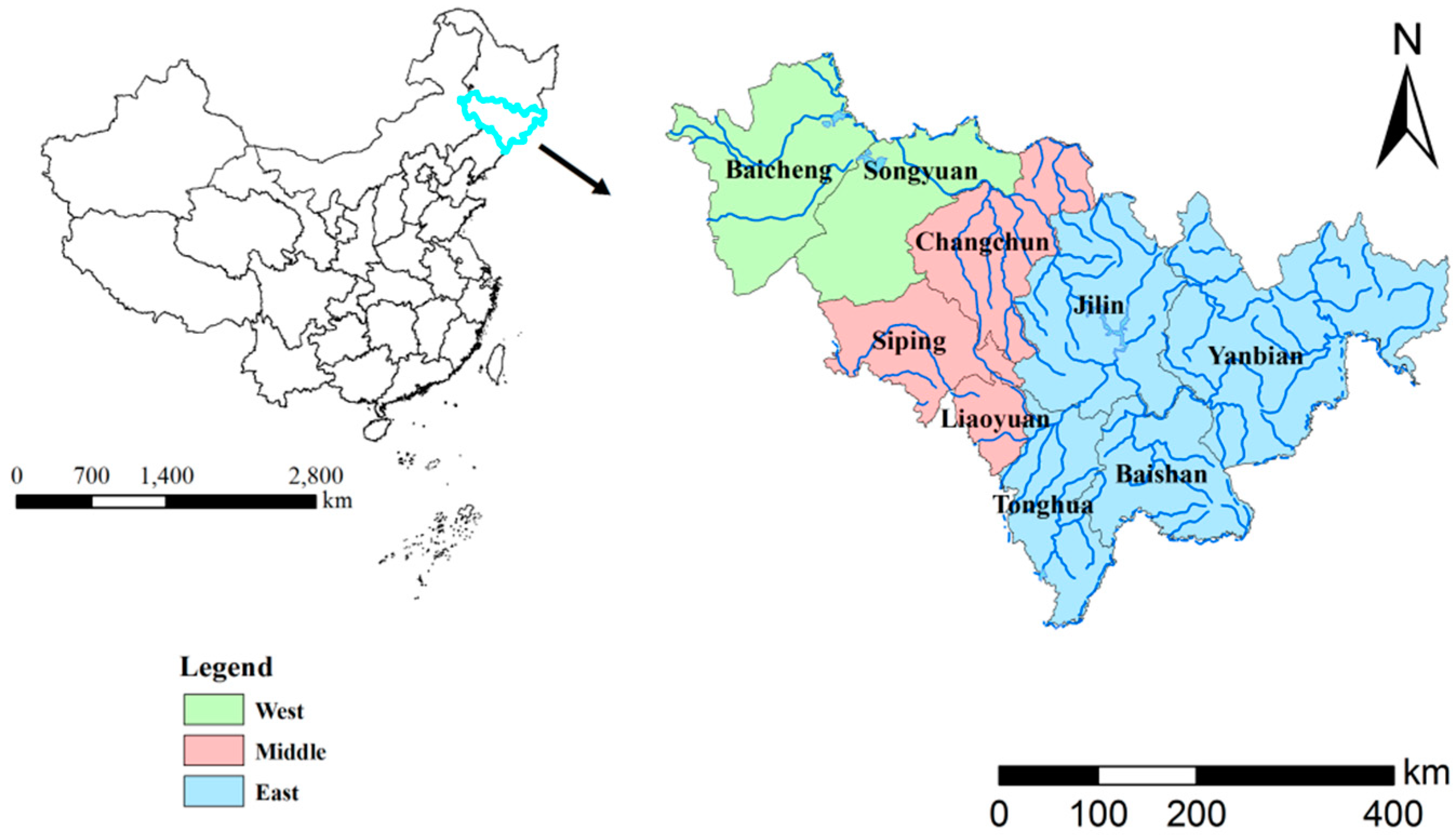
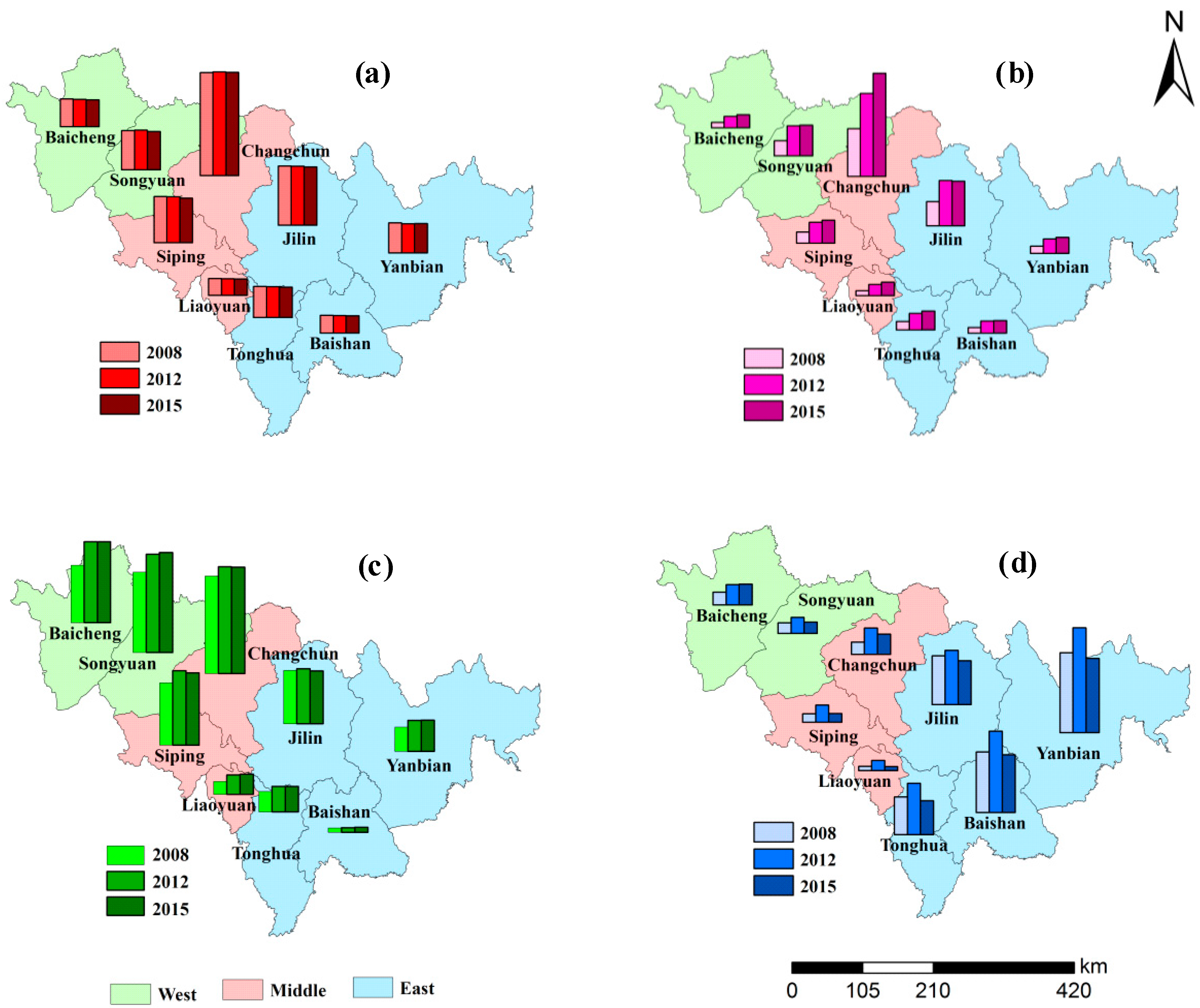
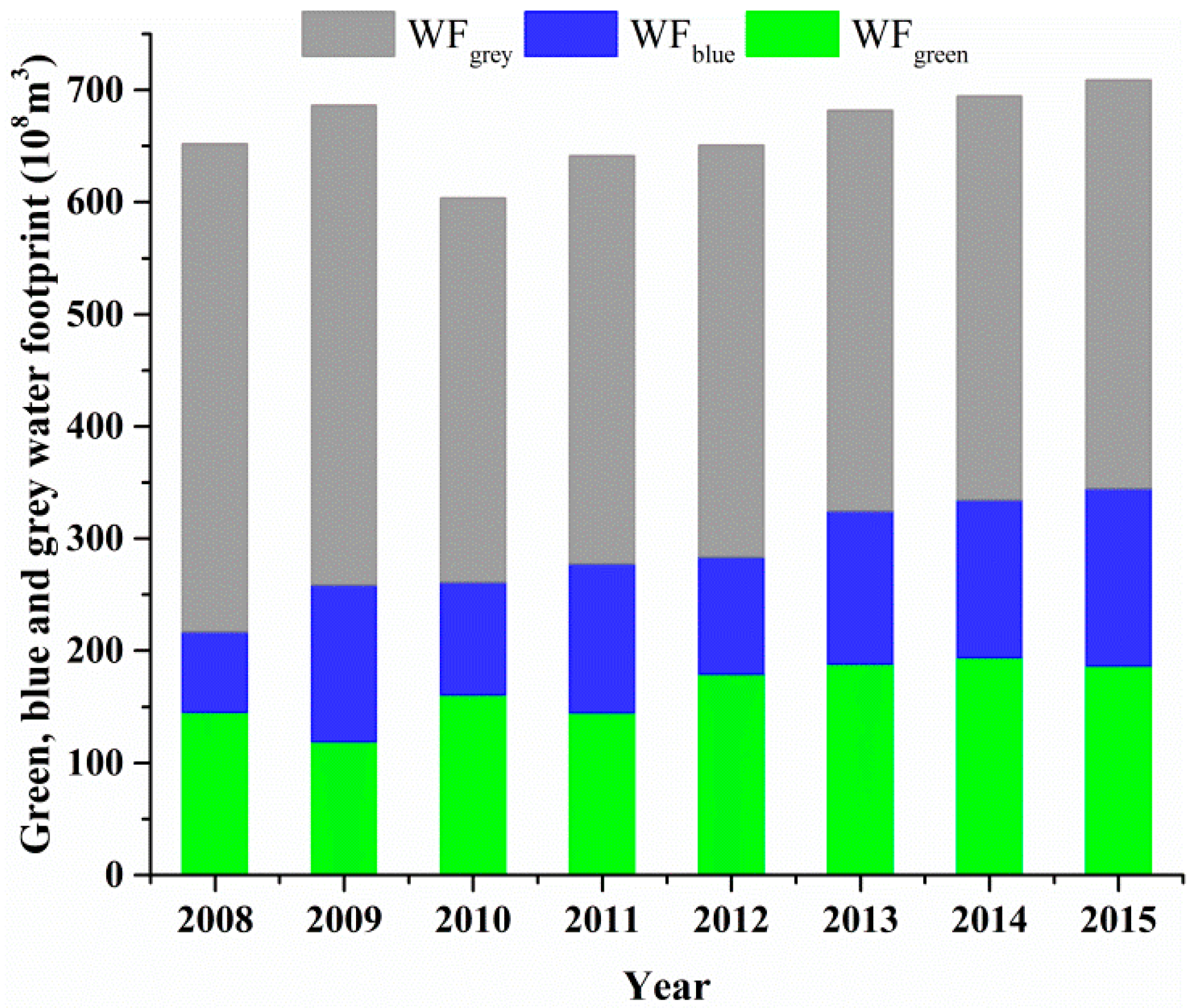
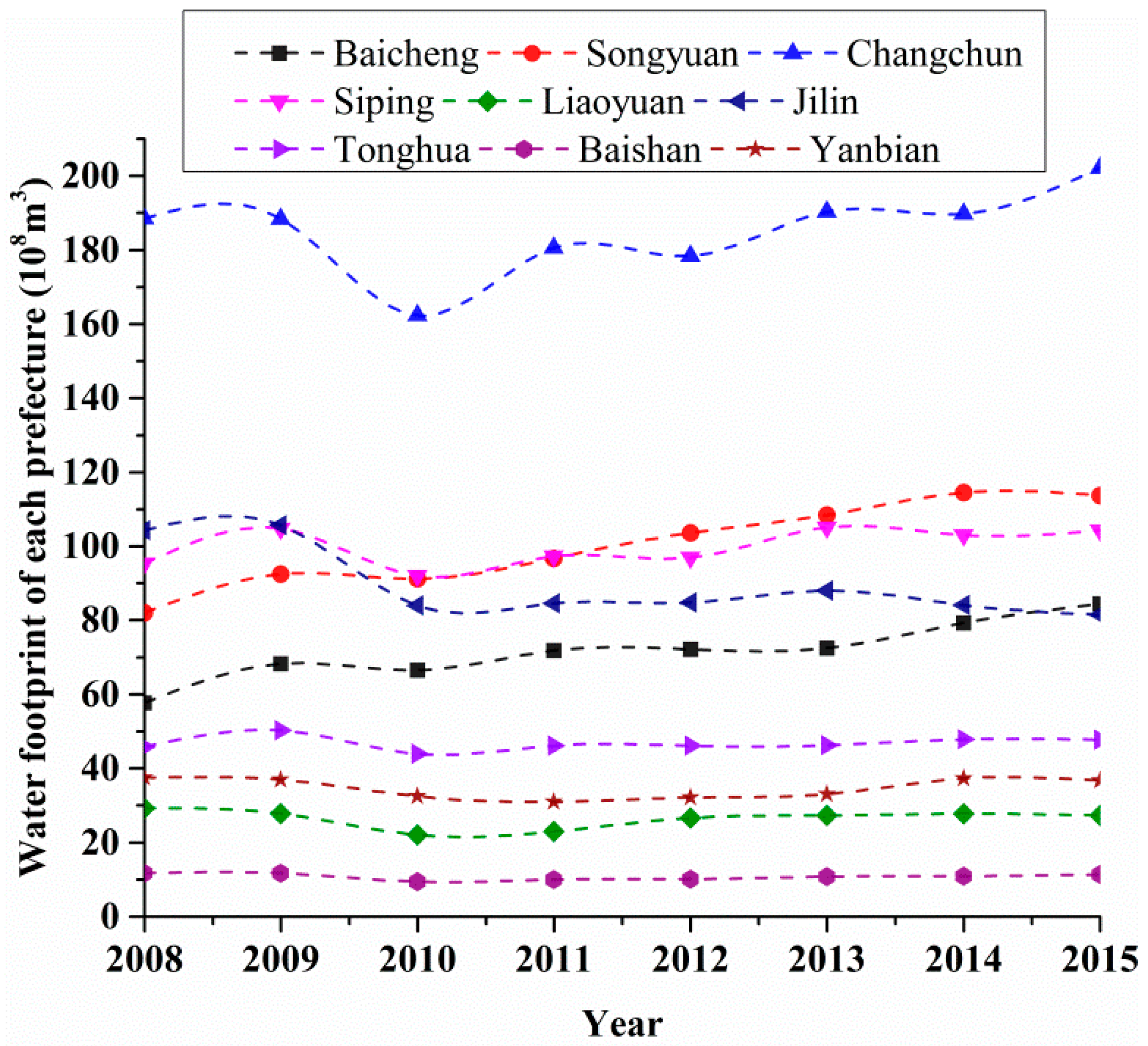
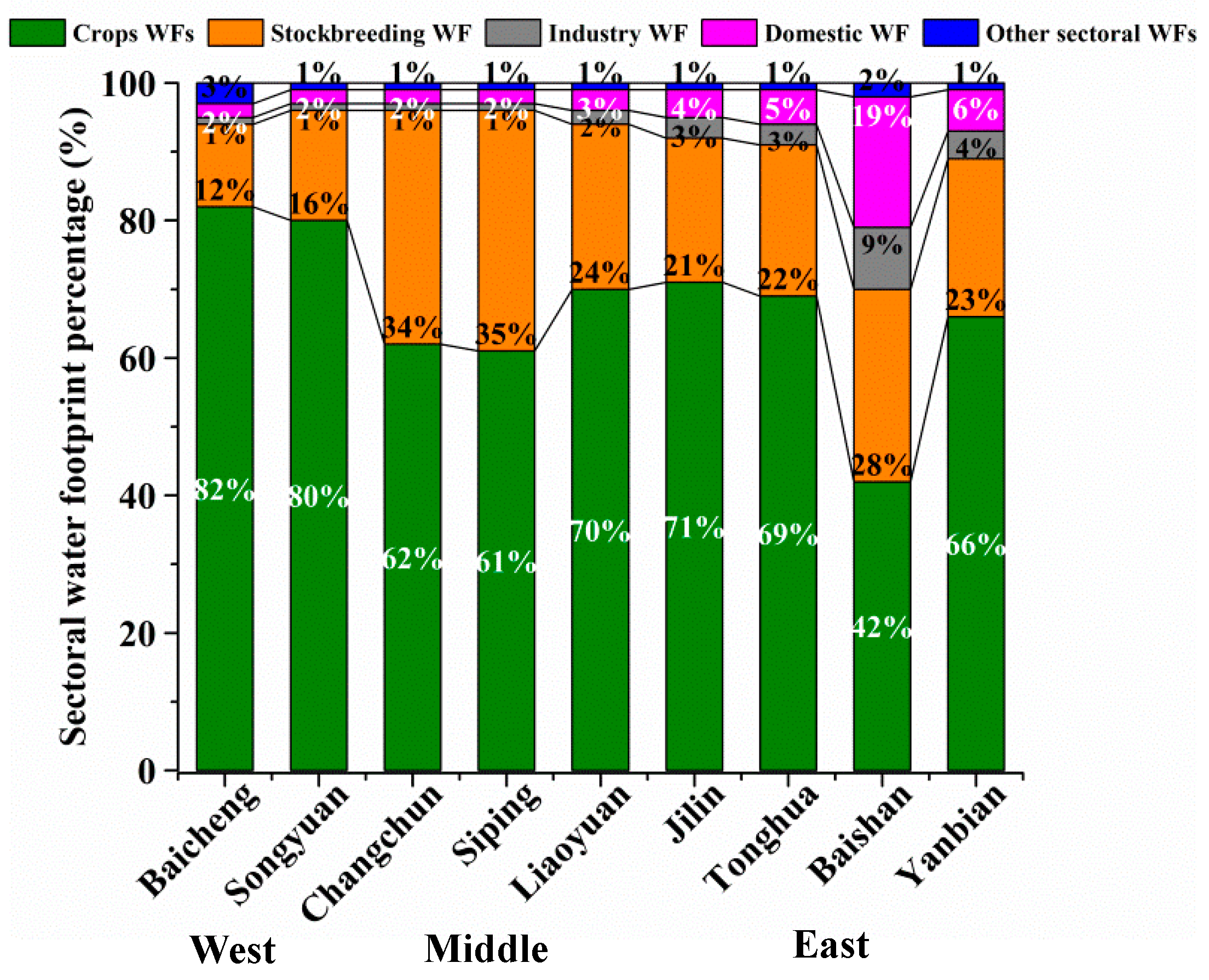

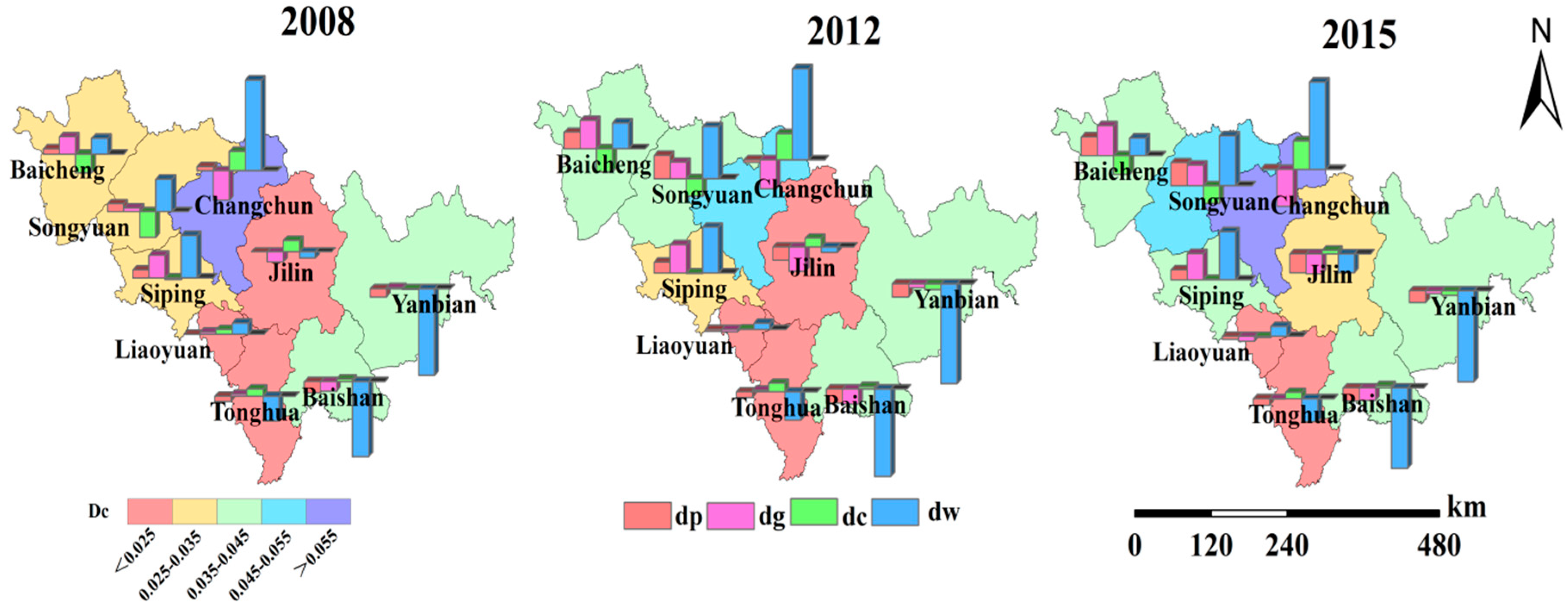

| Year | 2008 | 2009 | 2010 | 2011 | 2012 | 2013 | 2014 | 2015 |
|---|---|---|---|---|---|---|---|---|
| Comprehensive Gini coefficient | 0.247 | 0.254 | 0.263 | 0.267 | 0.266 | 0.273 | 0.265 | 0.275 |
| Baicheng | Songyuan | Changchun | Siping | Liaoyuan | Jilin | Tonghua | Baishan | Yanbian | ||
|---|---|---|---|---|---|---|---|---|---|---|
| 2008 | 0.010 | 0.015 | 0.008 | 0.015 | −0.000 | 0.000 | −0.010 | −0.021 | −0.016 | |
| dp | 2012 | 0.026 | 0.037 | −0.004 | 0.017 | −0.003 | −0.021 | −0.009 | −0.022 | −0.021 |
| 2015 | 0.032 | 0.039 | 0.001 | 0.017 | −0.005 | −0.032 | −0.011 | −0.022 | −0.020 | |
| 2008 | 0.033 | 0.007 | −0.056 | 0.043 | 0.004 | −0.019 | 0.004 | −0.018 | 0.002 | |
| dg | 2012 | 0.045 | 0.026 | −0.046 | 0.045 | −0.004 | −0.039 | 0.003 | −0.024 | −0.006 |
| 2015 | 0.051 | 0.035 | −0.063 | 0.045 | −0.008 | −0.034 | −0.000 | −0.021 | −0.005 | |
| 2008 | −0.036 | −0.049 | 0.037 | −0.003 | 0.009 | 0.022 | 0.014 | 0.005 | −0.001 | |
| dc | 2012 | −0.037 | −0.028 | 0.042 | −0.001 | 0.001 | 0.014 | 0.014 | 0.004 | −0.009 |
| 2015 | −0.032 | −0.030 | 0.049 | 0.001 | −0.002 | 0.006 | 0.011 | 0.004 | −0.008 | |
| 2008 | 0.030 | 0.062 | 0.173 | 0.081 | 0.021 | −0.012 | −0.047 | −0.143 | −0.165 | |
| dw | 2012 | 0.041 | 0.083 | 0.145 | 0.073 | 0.010 | −0.009 | −0.045 | −0.139 | −0.159 |
| 2015 | 0.030 | 0.085 | 0.149 | 0.082 | 0.017 | −0.032 | −0.039 | −0.137 | −0.155 |
© 2019 by the authors. Licensee MDPI, Basel, Switzerland. This article is an open access article distributed under the terms and conditions of the Creative Commons Attribution (CC BY) license (http://creativecommons.org/licenses/by/4.0/).
Share and Cite
Wang, J.; Qin, L.; He, H. Assessing Temporal and Spatial Inequality of Water Footprint Based on Socioeconomic and Environmental Factors in Jilin Province, China. Water 2019, 11, 521. https://doi.org/10.3390/w11030521
Wang J, Qin L, He H. Assessing Temporal and Spatial Inequality of Water Footprint Based on Socioeconomic and Environmental Factors in Jilin Province, China. Water. 2019; 11(3):521. https://doi.org/10.3390/w11030521
Chicago/Turabian StyleWang, Jianqin, Lijie Qin, and Hongshi He. 2019. "Assessing Temporal and Spatial Inequality of Water Footprint Based on Socioeconomic and Environmental Factors in Jilin Province, China" Water 11, no. 3: 521. https://doi.org/10.3390/w11030521
APA StyleWang, J., Qin, L., & He, H. (2019). Assessing Temporal and Spatial Inequality of Water Footprint Based on Socioeconomic and Environmental Factors in Jilin Province, China. Water, 11(3), 521. https://doi.org/10.3390/w11030521





